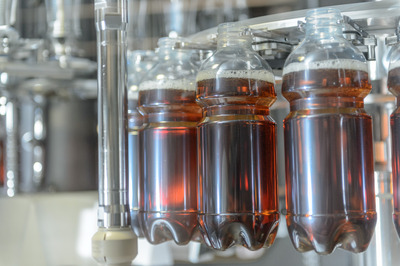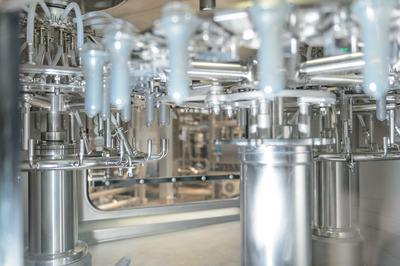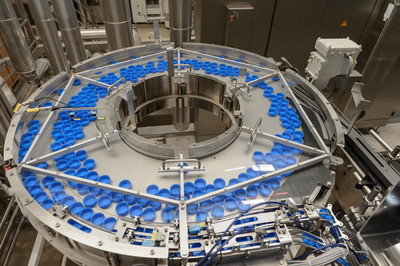Advances in aseptic beverage filling
Aseptics have now breached the final building block in a beverage bottling line with the incorporation of the stretch blow-moulding machine in the aseptic concept. Aseptics now extend from preform decontamination through the aseptic blow module and aseptic filler to the aseptic closer.
One of the biggest fruit and vegetable processors in Europe, the family-owned, German company Stute Nahrungsmittelwerke, has expanded its aseptic beverage capacities by installing the Krones Contiform AseptBloc.
Stute produces a wide range of soft drinks as well as preserved fruit and vegetables, desserts and sweet spreads like jams, marmalades and honey. It supplies markets in Europe, America and Australia, where it holds IP patents.
At its Paderborn production facility, Stute fills cans, soft packages, glass bottles and PET containers with carbonated soft drinks, ice teas and near-water beverages, fruit spritzers, squashes, concentrated and direct juices, and chilled fresh juices. The 500,000 m2 facility operates 36 soft-package lines, 13 aseptic PET lines rated at up to 40,000 bph, plus a beverage canning line and a glass line. Sales go mainly to large food and beverage discounters.

For many years, Stute has prioritised aseptic filling so as to achieve long-lasting freshness and a lengthy shelf life without using any preservatives or other additives. “Stute has committed itself unswervingly to operating without any preservatives. This means the kit involved has to offer manageable cleanrooms. When this became viable about a decade ago, Stute rigorously pursued the option of cold-aseptic filling,” explains Christoph Frankrone, head of purchasing plant engineering at Stute.
Stute started off with aseptic filling of beverage cartons, then took its first steps with aseptic linear fillers for PET, and subsequently with small cleanrooms in conjunction with rotary fillers. By 2008, Stute had installed a total of nine PET lines from a German vendor.
In 2009, Stute turned to Krones and commissioned a PET-Asept L wet-aseptic line for still beverages. This was followed in 2010 by two more Krones lines for carbonated beverages, this time with the Contipure module for preform decontamination and then in 2011 by the fourth Krones PET line, once again a PET-Asept L wet-aseptic line for still, low-acid beverages.
Production cycles of 140 hours targeted
With the Contiform AseptBloc, Stute is using a harmonised blow-moulder/filler monobloc in which the aseptics begin even before the stretch blow-moulding process. Previously, in its wet-aseptic operations, Stute had kept the blow-moulder and the filler separate. “We confidently expect the Contiform AseptBloc to give us substantially shorter make-ready times, reduced by about two-thirds, and are looking forward to a significantly improved concept for care and maintenance, firstly thanks to a reduced number of wear parts and secondly to more intelligent part replacement. We see shorter cleaning cycles of just two-and-a-half hours instead of four, and we shall be trying to extend the production cycles to 140 hours,” says Frankrone. That would indeed be a minor sensation.

The four Krones lines previously installed achieve 96 hours of production time, while the figure for the older aseptic lines is 72 hours.
“We also anticipate that the new line will enable us to reduce the preform weights still further. As far as the microbiological situation is concerned, we are confident that in future we shall be achieving germ reduction rates inside the bottle of up to log 6. On the two wet-aseptic lines we’re running at log 5, while for the lines featuring the Contipure module, log 4 suffices because of the carbon dioxide content in the products concerned.”
Maximally fresh products on the market at high turnaround speeds
The firm’s corporate philosophy emphasises continual upgrading of the production operations and purposeful deployment of the very latest technologies. Since 2006 alone, Stute has invested around 100 million euros in modernising and expanding its aseptic beverage capacities and its local infrastructure, so as to put large quantities of maximally fresh products on the market at high turnaround speeds.
With the Contiform AseptBloc, the preforms are treated with gaseous hydrogen peroxide after being warmed up and then passed directly to the blow module where the containers are produced under aseptic conditions. They are then filled in aseptic mode and fitted with decontaminated closures. All the machines in the system are monobloc-synchronised and are operated using a higher-order control system.
The system makes no compromises in terms of microbiological safety as it offers complete coverage down the aseptic chain - from decontamination of the preforms to closing of the bottles.
Moreover, the line eases the workload for the production staff and takes up significantly less space: Stute installed a Contiform AseptBloc rated at 24,000 bph, which requires 40% less space than a comparable PET-Asept D dry-aseptic system. [A 32,000 bph Contiform AseptBloc can be installed on an area that’s about a third smaller than that of a PET-Asept L wet-aseptic system with the same rating.]
And that’s not all - the total cost of ownership (TCO) is lower than with comparable conventional aseptic monoblocs. Thanks to the significantly lower costs for processing and operating materials and for care and maintenance, cost savings of more than 10% are claimed.

“The reduction in operating costs was one of the crucial factors when it came to deciding on this investment,” emphasises Frankrone. “The lower costs for the processing and operating materials show up to particular effect here, as do the lower maintenance costs. Because the production running times are longer, the costs for processing and operating materials are automatically downsized.”
Aseptic blow module
The Contiform A stretch blow-moulding machine has been designed so as to ensure that now only the moulds and absolutely essential components are located inside the aseptic zone. All other assemblies, cables, sensors and pneumatics have been removed from this area.
Several design building blocks help to make sure that the sterile zone is partitioned off from the rest of the machine. These include a defined overpressure in the entire aseptic area provided by a central ventilation system and a hydraulic liquid seal with an H2O2 solution. The electromagnetically driven stretching unit never leaves the sterile zone. Next to the stretching rods are only the left and right stainless steel mould halves with base and the aluminium moulds in the aseptic zone of the blow-moulding machine.
Gaseous hydrogen peroxide from a central processing unit is used for sterilising the surfaces of the machines and also for preform and closure decontamination.
For sterilising the high-pressure air routes, the paths from the rotary manifold are warmed up with hot air and then cleaned by means of an H2O2-air mixture. By sterilising the blowing paths and the blowing wheel isolator, a flawless microbiological state is assured in preproduction.
The product path and the isolator are cleaned simultaneously, in each case with hot caustic and acid, without any foam agents. A simple CIP system suffices for this purpose: neither a sterile-water UHT system nor a hygiene centre is required. This reduces the complexity of the cleaning process and downsizes the duration of the requisite cleaning routine to less than 2.5 hours.
Decontaminating the preforms creates a whole series of advantages as compared to sterilising the finished, blow-moulded PET containers. The preforms offer a significantly simpler shape and a considerably smaller surface area. In contrast to bottles, moreover, with preforms there is no risk of shrinkage. This firstly enables the bottle’s weight to be reduced, with concomitant savings in material, and secondly renders a Relax blow-moulding process obsolete. The process window, too, for reaching the germ reduction is significantly greater than for bottles, which increases the dependability and stability of the process.
The preform feed has been constructed in hygienic design: both the preform magazine and the preform chute have been fitted with covers. Moreover, a rinser uses ionised air to remove dust and smaller particles from the preforms. In order to upgrade the efficacy still further, a camera system inspects the geometry of the neck finish and will reject any non-conforming preforms.
The closure sterilisation unit, likewise new, is based on a simple, sturdy mechanical design. Over a short distance, the closures are sterilised within a minimised time frame by means of evaporated hydrogen peroxide.
From an environmental viewpoint, the Contiform AseptBloc scores highly by managing entirely without water during sterilisation and production modes. Water is now only required for cleaning. Thanks to the design concept for the cleanrooms, the overall media consumption is low. Hydrogen peroxide as a sterilising medium can likewise per se be described as eco-friendly: it breaks down into water and oxygen.
“Our aim is to be as far out in front as possible when it comes to technology,” emphasises Frankrone. “The Contiform AseptBloc we now have replaces an older aseptic linear filler. We intend to successively replace the other linear lines as well, and thus at the same time increase our output. We see this fresh innovation from Krones as very well suited for this, particularly in regard to a possible reduction in the container’s weight.”
For the sake of saké: combating beverage fraud in Japan
In order to help combat the global issue of saké fraud, researchers have developed an...
Hygienic design: keeps the bugs away
When sanitisation practices are insufficient, listeria can harbour and thrive in many pieces of...
Meat processing: a case study of Triton and GMP collaboration
Gundagai Meat Processors (GMP) and Triton Commercial Systems have collaborated on an innovative...












